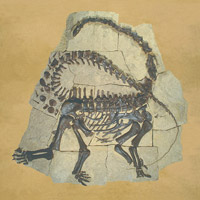August at The Walt Disney Family Museum features Walt Disney’s classic Fantasia (1940), a musical masterpiece that features the talent of renowned conductor Leopold Stokowski, and led to the development of stereophonic surround sound. As Fantasia is a feature film made up of eight animated segments, we've taken the film apart to focus on each segment individually. As we turn our attention to dinosaurs, we've asked our neighbors across the park--San Francisco's leading science experts--to chat with us about these fascinating prehistoric creatures. California Academy of Sciences gives us a closer look at the "Rite of Spring"... check out what they've uncovered!
 In the “Rite of Spring” segment of Fantasia, there is a scene in which several dinosaurs perish in the desert, and presumably become fossilized for future paleontologists to uncover.
In the “Rite of Spring” segment of Fantasia, there is a scene in which several dinosaurs perish in the desert, and presumably become fossilized for future paleontologists to uncover.
This scene calls to mind “the death pose” of some fossils, especially sauropods. Sauropods were long-necked, plant-eating dinosaurs that evolved to be the largest land animals on Earth. Their fossilized remains are often found with the necks bent dramatically backward. Early scientists therefore assumed that sauropod necks were flexible in life and capable of reaching great heights, perhaps so the animal could nibble on tree leaves.
Modern paleontologists, however, decided to look more closely at the structure of the neck vertebrae, and they realized that such flexibility was impossible. If a sauropod tried to bend its neck backwards, the joints would have slipped and become dislocated. Computer programs that reconstruct dinosaur bones and muscles and simulate their motion corroborated these findings. So what explains the twisted posture of the fossils?
 It turns out that in many animals—including humans—bands of elastic tissue called ligaments connect different bones to one another, forming joints. Ligaments also spanned the neck bones of sauropods. When the animal died, the ligament shrank and caused the neck to curl backwards into the classic “death pose.” Living sauropods, on the other hand, probably held their heads lower to the ground.
It turns out that in many animals—including humans—bands of elastic tissue called ligaments connect different bones to one another, forming joints. Ligaments also spanned the neck bones of sauropods. When the animal died, the ligament shrank and caused the neck to curl backwards into the classic “death pose.” Living sauropods, on the other hand, probably held their heads lower to the ground.
We hope you enjoyed these special screenings of Fantasia at the The Walt Disney Family Museum, and invite you to travel through time and learn about the fascinating animals that once roamed the Earth at the California Academy of Sciences. Come see an exciting new 3D movie and live programs exploring the world of prehistoric creatures, including dinosaurs and sharks, during “Jurassic in the Park” starting September 4. Learn more: http://www.calacademy.org/events/jurassic/.
[Image: Diplodocus death pose, Howe Ranch. Courtesy American Museum of Natural History.]
